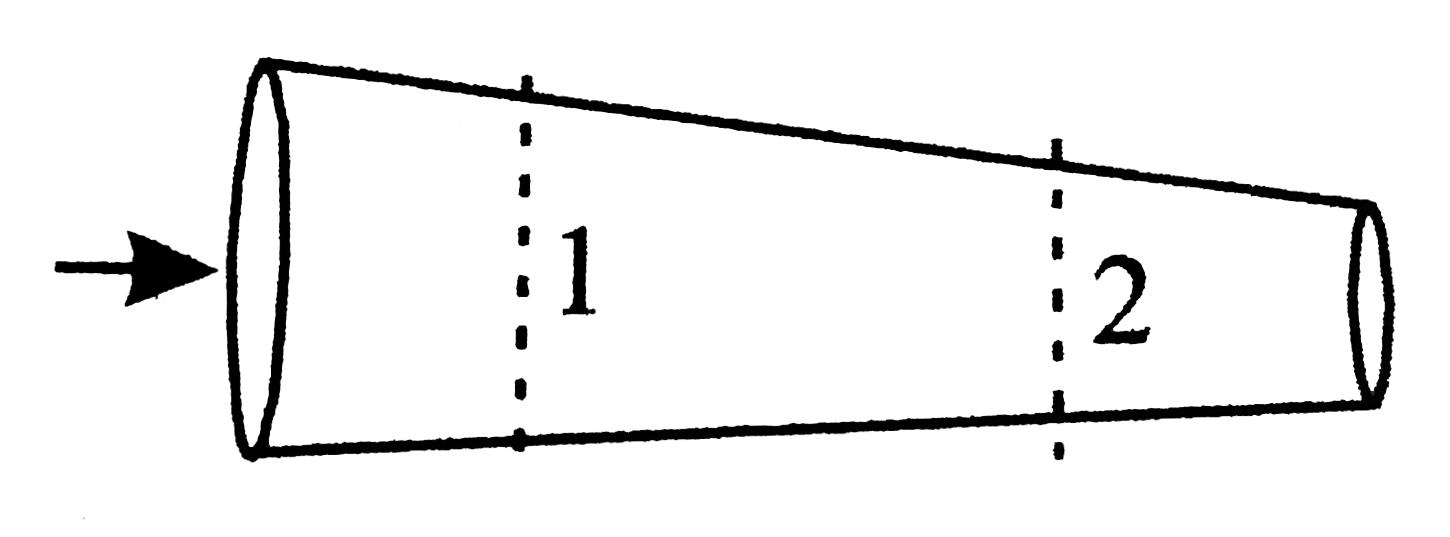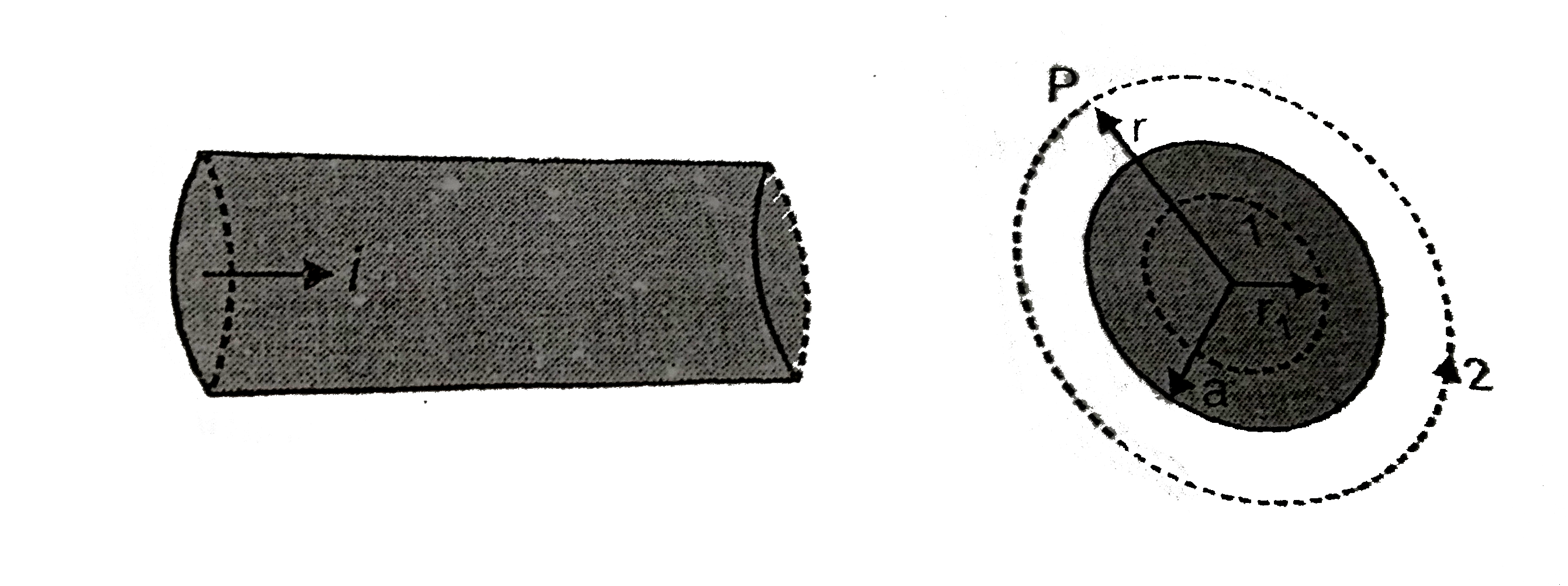A wire of radius R having uniform cross section in which steady current l is flowing. Then
a. Magnetic field increases linearly with the distance from the axis of the wire
b. Magnetic field is maximum at the surface of the wire
c. Magnetic field decreases hyperbolicaly, outside the wire, with the distance from the axis
d. Magnetic field remains constant as the wire is infinite
The correct Answer is:A, B, C
To solve the problem regarding the magnetic field around a wire with a steady current, we will analyze the situation step by step.
1. Understanding the Setup:
We have a wire of radius R with a steady current I flowing through it. We need to analyze the magnetic field B at different distances from the wire.
2. Applying Ampere's Law:
According to Ampere's Law, the line integral of the magnetic field B around a closed loop is equal to μ0 times the current enclosed by that loop:
∮B⋅dl=μ0Ienclosed
We will consider two cases: inside the wire (where r<R) and outside the wire (where r>R).
3. Case 1: Inside the Wire (r<R):
- The current density J is uniform, so the current enclosed by a circle of radius r is:
Ienclosed=I⋅πr2πR2=I⋅r2R2
- Using Ampere's Law:
B⋅(2πr)=μ0Ienclosed=μ0I⋅r2R2
- Solving for B:
B=μ0Ir2πR2
- This shows that B increases linearly with r (as r increases, B increases).
4. Case 2: Outside the Wire (r>R):
- The total current I is enclosed by any circle of radius r:
Ienclosed=I
- Again using Ampere's Law:
B⋅(2πr)=μ0I
- Solving for B:
B=μ0I2πr
- This shows that B decreases inversely with r (as r increases, B decreases).
5. Maximum Magnetic Field:
- At the surface of the wire (r=R):
B=μ0I2πR
- This is the maximum value of the magnetic field.
6. Conclusion:
- From the analysis, we conclude:
- The magnetic field increases linearly with the distance from the axis of the wire inside the wire.
- The magnetic field is maximum at the surface of the wire.
- Outside the wire, the magnetic field decreases inversely with distance.
- The magnetic field does not remain constant as the wire is infinite.
Final Answers:
- Correct options are:
- A: Magnetic field increases linearly with the distance from the axis of the wire.
- B: Magnetic field is maximum at the surface of the wire.
We have a wire of radius R with a steady current I flowing through it. We need to analyze the magnetic field B at different distances from the wire.
According to Ampere's Law, the line integral of the magnetic field B around a closed loop is equal to μ0 times the current enclosed by that loop:
∮B⋅dl=μ0Ienclosed
We will consider two cases: inside the wire (where r<R) and outside the wire (where r>R).
- The current density J is uniform, so the current enclosed by a circle of radius r is:
Ienclosed=I⋅πr2πR2=I⋅r2R2
- Using Ampere's Law:
B⋅(2πr)=μ0Ienclosed=μ0I⋅r2R2
- Solving for B:
B=μ0Ir2πR2
- This shows that B increases linearly with r (as r increases, B increases).
- The total current I is enclosed by any circle of radius r:
Ienclosed=I
- Again using Ampere's Law:
B⋅(2πr)=μ0I
- Solving for B:
B=μ0I2πr
- This shows that B decreases inversely with r (as r increases, B decreases).
- At the surface of the wire (r=R):
B=μ0I2πR
- This is the maximum value of the magnetic field.
- From the analysis, we conclude:
- The magnetic field increases linearly with the distance from the axis of the wire inside the wire.
- The magnetic field is maximum at the surface of the wire.
- Outside the wire, the magnetic field decreases inversely with distance.
- The magnetic field does not remain constant as the wire is infinite.
- Correct options are:
- A: Magnetic field increases linearly with the distance from the axis of the wire.
- B: Magnetic field is maximum at the surface of the wire.
Topper's Solved these Questions
- MOVING CHARGES AND MAGNETISMBOOK - AAKASH INSTITUTE ENGLISHCHAPTER - MOVING CHARGES AND MAGNETISMEXERCISE - Assignment Section D (Linked Comprehension Type Questions)
10 Videos
- MOVING CHARGES AND MAGNETISMBOOK - AAKASH INSTITUTE ENGLISHCHAPTER - MOVING CHARGES AND MAGNETISMEXERCISE - Assignment Section E (Assertion - Reason Type Questions)
9 Videos
- MOVING CHARGES AND MAGNETISMBOOK - AAKASH INSTITUTE ENGLISHCHAPTER - MOVING CHARGES AND MAGNETISMEXERCISE - Assignment (Section B) Objective Type Questions (One option is correct)
35 Videos
- MOVING CHARGE AND MAGNESIUMBOOK - AAKASH INSTITUTE ENGLISHCHAPTER - MOVING CHARGE AND MAGNESIUMEXERCISE - SECTION D
16 Videos
- NUCLEIBOOK - AAKASH INSTITUTE ENGLISHCHAPTER - NUCLEIEXERCISE - ASSIGNMENT (SECTION-D)
10 Videos
Similar Questions
A square loop of length L is made of wire of uniform cross-section carrying current l as shown in figure then magnetic field at centre of square is
View SolutionConsider a conductor of variable cross section in which current is flowing from cross section 1 to 2. Then

View SolutionThe diameter of a metallic sphere is equal to 9 cm. It is melted and drawn into a long wire of diameter 2 mm having uniform cross-section. Find the length of the wire.
View SolutionA cylinder wire of radius R is carrying uniformly distributed current I over its cross-section. If a circular loop of radius r is taken as amperian loop, then the variation value of ∮→B⋅→dl over this loop with radius 'r' of loop will be best represented by
View SolutionFigure shows a long straight wire of a circular cross-section (radius a) carrying steady current l. The current l is uniformly distributed across this cross-section. Calculate the magnetic field in the region r<aandr>a

View SolutionA long straight wire of a circular cross section (radius a) carrying steady current. Current is uniformly distributed in the wire. Calculate magnetic field inside the region (r<a) in the wire.
View SolutionA long cylinder of uniform cross section and radius R is carrying a current i along its length and current density is uniform cross section and radius r in the cylinder parallel to its length. The axis of the cylinderical cavity is separated by a distance d from the axis of the cylinder. Find the magnetic field at the axis of cylinder.
View SolutionThe magnetic field due to a conductor fo unifrom cross section of radius a and carrying a steady current is represented by
View SolutionA long straight wire of a curcular cross-section of radius 'a' carries a steady current 'l'. The current is uniformly distributed the across- section . Apply Amphere's circuital law to calculate the magnetic field at a point 'r' in the region for (i) r<a and (ii) r>a.
View SolutionA long straight wire of a circular cross-section of radius 'a' carries a steady current I. The current is uniformly distributed across the cross-section. Apply Ampere's circuital law to calculate the magnetic field at a point at distance 'r' in the region for (i) r<a and (ii) r>a.
View Solution
